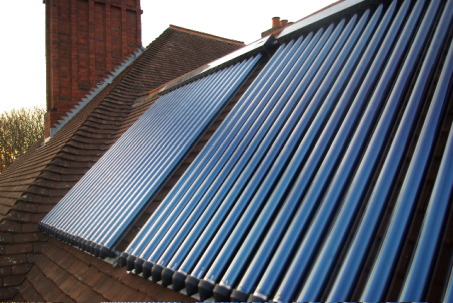How Much Solar Thermal Do I Need? - System Sizing
The relationship between solar collector capacity and cylinder capacity is a critical one. If you get it right then you'll have a good spread of solar energy creating usable hot water over the year. Get it wrong and you'll either have an overheated cylinder in the summer or tepid water in the height of summer and no hot water in the winter at all!
To get back to the title – how much solar thermal do I need, you'll see that the answer is very much dependent on the capacity of your cylinder and what you want to use the heat for. Just for this blog we'll consider solar for hot water and not solar for space heat. If the collector is too large for the cylinder then the water will get too hot, energy will be wasted and the system could be damaged. If the collector is too small for the cylinder then the result will be water that is too tepid to use for most of the year. So what do I mean by too large and too small?
To explain the relationship between collector and cylinder I need to introduce you to another term – 'Dedicated Solar Volume'. As the name suggests this is the volume of the cylinder that only the solar thermal collector can heat. Heat in cylinders is not spread uniformly, if you put heat in at the top then it stays there and the temperature at the bottom does not increase noticeably. Under normal conditions you could have 15 degrees at the bottom of a cylinder and 65 at the top!
If your solar coil is at the bottom of the cylinder then it can heat the whole cylinder. If you have another coil two thirds up the cylinder then the volume that the solar can heat alone is the distance from the bottom of the cylinder to the bottom of the other coil. This other coil is generally for a fossil fuel back up heat source such as a gas boiler. The relationship between the positioning of these two coils is again a critical one. If the dedicated solar volume is too large relative to the back-up volume then you will run out of hot water in the winter.
If we use an example of a 210 litre twin coil cylinder we can divide it into three sections of 70 litres. If the back-up boiler is heating the top third, then that is 70 litres of hot water in the winter months, the remaining 140 litres is 'dedicated solar volume'. Unfortunately this is not enough hot water for most households; a better coil layout for this size of cylinder might be a 50/50 split between the two heat sources. Now we have a more realistic 105 litres of hot water in the winter and 105 litres of solar volume. According to the energy saving trust (CE131, Energy Saving Trust, 2006) the dedicated solar volume should be the greater of the expected domestic daily hot water use, or 35 litres per meter squared of net collector area.
Now we know our dedicated solar volume we can work out the size of the collector required. Taking the 105 litres from the example we would need 3m² (105/35), this requirement could be met by 2 flat plate collectors or 30 evacuated tubes giving an equivalent net area. The 'net' area is the amount of collector exposed to the sun after the area of the frame has been deducted.
So there we have it – the size of the solar thermal collector depends on the size of the dedicated solar volume of the cylinder.














